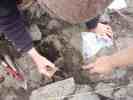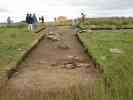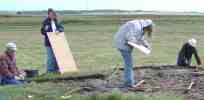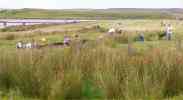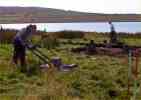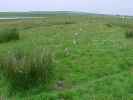 | Caithness.Org | Community | Business | Entertainment | Caithness... | Tourist Info | Site Map |
• Advertising • Chat Room • Contact Us • Kids Links • Links • Messageboard • News - Local & Scottish • News - UK & News Links • About / Contact Us • Submissions |
• Bookshop • Business Index & News • Jobs • Property For Sale • Property For Rent • Shop • Sutherland Business Index |
• Fishing • Fun Stuff • George, The Saga • Horses • Local Galas • Music • Pub Guide • Sport Index • What's On In Caithness |
• General Information • B & Bs • Backpackers • Caravan & Camping • Ferries • Getting Here • Holiday Letting • Hotels • Orkney • Pentland Firth • Sutherland • Taxis |
| N E W S F E E D S >>> |
Battlemoss Excavation
8 - 28 August 2003
|
Battlemoss Excavation Updates 31 August
2003 The last few days were taken up with the final recording and back filling of the trenches over the stone rows, and the continued investigation of the cairn. The large slab identified in the central area of the cairn (the putative cist) was lifted on Tuesday afternoon, and revealed no immediate evidence for a stone-lined cist or further burials. However, we are not certain that we have reached the base of the archaeology in this part of the monument. Further work to reveal the true shape of the central area of the cairn took place on Wednesday � the settings of large stones now appear to define an oval rather than round space. Whilst digging through the upper layers of material filling the centre of the cairn a large quantity of pottery was revealed, which ensured another late night on site! This looks to be Beaker pottery, belonging to the earliest phases of the Bronze Age, and may be older than the pottery found elsewhere in the monument. No evidence for burials or other grave goods were found associated with this pottery, although a complete excavation of the surrounding area was not possible due to time constraints. Although we have revealed a large amount of the cairn, we are not yet happy that we understand exactly how it was constructed and used. So, we took a decision on Thursday to cover the site over and return next year to finish the investigation! This will enable us to review all of the results from this years work and return next year with specific questions to answer through further excavation. In the meantime, we will be providing updates on the project on this website as the finds and the data are processed. We will also publish our interim report here later in the year. Andrew and Kenny will also be presenting the results of the excavation at the Highland Archaeology Week conference in Inverness in October. This has been a very successful project, and Andrew, Kenny and I would like to thank everyone who was involved. We would particularly like to thank our stalwart local volunteers Meg Sinclair, Nan Bethune, Paul Humphries, George and Kathleen MacDougall, Calum and Janet MacKenzie, Alasdair Japp and Gordon Smart. We were also extremely pleased with the turn out for our open day on the 23rd, and would like to thank everyone who visited for their interest in the project. Thanks also to Bill Fernie for providing the website facilities on Caithness.org � and for taking so many great photos! Finally, we would like to thank Sybil and James Mackay for allowing us to excavate in their field, and for all the interest they have shown in the project over the last few years (and in advance for allowing us to come back next year!). Thanks also to Islay MacLeod and the Thrumster Estate for their support of the project, and to Islay for accommodating the students for the last 3 weeks! We would like to acknowledge both CASE and the CED for providing the majority of the funding for this years work � thanks to Eann Sinclair for all his help over the last few months. Thanks also to the Highland Council Roads Department for the use of their surveying equipment. Thanks also to Noel Fojut at Historic Scotland for his support and advice during the planning of this project
26 August 03
24 August
03 Open Day At
Battlemoss
22 August 03 Stone rows We have a better understanding of the process of erection of the stones now as well. It seems a slot just bigger than the stone was dug out of the hard boulder clay subsoil, and the bottom of the hole may have been lined with clay that the stone was �stuck� into. Packing stones were then jammed in on either side of the stones, sometimes all around them, and after that an artificial surface may have been spread up to and around the stones to level the area. We cannot say for sure that this sequence was followed at all stones � we have only excavated 5 so far, but will look at a few more over the coming days. Cairn The next few days will be exciting in the cairn. At least one large flat stone has to be moved, and we suspect it may be covering another burial. We are also starting to remove rubble-like cairn material from the centre of the monument within what may be a chamber or kerb-defined area. Clearly, this cairn was the focus for several burials over an unknown period of time, although everything we have found so far points to the Bronze Age.
16th August 2003 The cairn As noted in earlier entries for the dig, we opened a small trench over the putative cairn earlier in the week. This revealed a very stony area immediately beneath the surface, which included some large flat stones. This was an unlikely location for a clearance cairn (near the middle of the field), and so we extended the trench to establish the full extent of the stony concentration. Careful cleaning of these new trenches established a clear edge for the stony area on all four sides, and occasional flint pieces were found amongst the stones. Team members then drew each stone on the site plan to allow a full record of this layer of the feature to be taken, before we started to remove the stones on the upper surface. This painstaking process of excavation finally allowed us to confirm that this was the location of a prehistoric cairn, when on Saturday remnants of cremated bone and a few sherds of coarse pottery were found amongst the stones, almost certainly the remnants of a cremation burial. A small fragment of metal found may have been buried with the human remains. The location of these finds � off-set from the centre, and near the top, of the cairn material � suggests that this is a secondary burial. This basically means a burial dug into an older burial cairn, and this is the focus of continued investigation. It is too early to speculate on the significance of this discovery. We can get dating information from the cremated bone for an accurate date, but we already know that this form of burial was commonly carried out in the Bronze Age. This does not shed light on the date of the stone rows nor do we have any idea of the relationship between the two, but clearly their close proximity and the alignment of the rows on the cairn suggests that the two were in some way related. A much larger Bronze Age burial cairn lies nearby on the Yarrows Heritage Trail and was excavated in the late 19th century by Joseph Anderson. The stone
rows Several of the stones have now been excavated, one fully, and we have a clearer understanding of how they were erected. The holes the stones were placed in are relatively small, with room only for the stones to be placed in and flagstone packing to be jammed in on either side to hold the stone in place. Material dug out of the holes in the first place was also used in the packing, making the edges of the stone holes difficult to find and record. As yet, no artefacts or dateable material have been found within the stone holes, although it is still early days. Excavation is a destructive process and should not be undertaken lightly or wastefully. We are digging only a small proportion of the monument, and less than 10% of the stones will in any way be excavated. Those that are, are painstakingly recorded, and each piece of packing stone is marked with chalk and set aside so that it, and the stone, can be replaced in the same hole. This will give us an idea of the difficulty of erecting the stones, but will also mean that the site will be preserved in its current state for future generations.
15 August
03
13th August 2003 The stone
rows A second trench has also been opened along the rows, but in this case on the south side of the fence that divides heather moorland from the field that most of the stones sit within. Several stones had been tentatively linked to the rows in this location, largely obscured by thick peat, but only now can we confirm that the rows continue on this side of the fence. So far, two complete stones and packing have been exposed, and the possible sockets of a further two have also been identified, although not yet tested by full excavation. We can now say with some certainty that the longest rows at Battle Moss include at least 20 stones, longer than any row at the Hill o� Many Stanes. Although many observations about the nature of the stone rows can only be speculative at this point, there are a few interesting things we are investigating and can test through more detailed excavation. One of the intriguing things about the stones is that some of them seem to be surrounded by a �halo� of tough, gritty material that may well be the upcast material thrown up when the stone holes were dug, and then trampled into the ground or used as packing material to support the stones. It is not often in archaeology that we can see individual events as clearly as this. Hopefully further excavation can bring us closer to those who built and used this monument. The cairn The next
few days
10 August 2003
The trench opened over the buried feature revealed what appeared at first to be a possible pit with a modern field drain cut through the eastern side. However, on excavation this was found to be a hole left by the removal of a large stone, perhaps during ploughing. The de-turfing of the trench over the possible cairn revealed a mass of small stones that appears to have a defined edge on the western side. This trench is only in its very early stages and so it is not possible to comment further at present. This diary will be updated regularly, with the students taking part in the project providing a personal reflection of the excavation and its findings. |
7 July 03 |
|
See Also Stone Rows Multiple Stone Rows Of Caithness & Sutherland - L J Myatt Gives list of sites and distribution map Multiple Stone rows of Caithness & Sutherland I R Free & L J Myatt Descriptions and diagrams of stone layout at various sites Multiple Stone Rows Of Caithness & Sutherland L J Myatt Possible purpose of the stone rows A Setting Of Stone rows - Tormsdale - L J Myatt Results of a survey summer 1984
Other Archaeology In Caithness Other Items By Amelia Pannett on
Caithness.org Archaeology And Art Main Archaeology Index on Caithness.org Contacts Want To Work On The Battlemosss Site
Excavation? |



